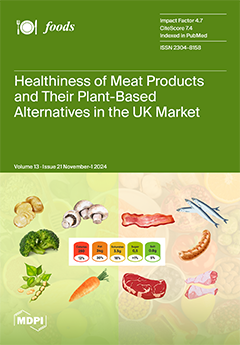Douchi is a kind of soybean-fermented food in China. To explore the common and differential compounds in different Douchi, Douchi was fermented by
Aspergillus niger,
Rhizopus arrhizus, and
Bacillus circulans, respectively, and co-fermented by the three strains in this study. The common and characteristic flavor compounds and common and characteristic non-volatile components of different strains of fermented Douchi were explored through GC×GC-TOFMS and UPLC–Q-TOFMS omics analysis. The result suggested that Pyrazines, ketones, and alkenes such as tetramethyl-pyrazine, 2,5-dimethyl pyrazine, furaneol, 2,3-butanedione, gamma-terpinene might contribute to the basic flavor of the Douchi fermented by
A. niger,
R. arrhizus, and
B. circulans. Peptides, amines, and flavonoids, such as N–acetylhistamine, 7,3′,4′–trihydroxyflavone, (3S,8As)-3-isobutylhexahydropyrrolo[1,2-a]pyrazine-1,4-dione might contribute to the basic function of the above three Douchi. The common metabolic pathways involved in the fermentation were isoflavonoid biosynthesis, flavonoid biosynthesis, etc. Ketones and esters such as 2,3-dihydro-3,5-dihydroxy-6-methyl-4H-pyran-4-one, 3-octanone, 5-methylfurfural and nonanal contributed to the unique flavor, while betaine, oleanolic acid, saikosaponin D and leucine might contribute to the unique function of
A. niger fermented Douchi. Alkenes, pyrazine, and ketones such as α-terpinene, ethyl-pyrazine, dihydro-3-methyl-2(3H)-furanone, and linalool might contribute to unique flavor, while cordycepin, 2-Phenylacetamide might contributed to the unique function of
R. arrhizus fermented Douchi. The unique flavor of
B. circulans fermented Douchi might derived from ketones and esters such as 3-acetyl-2-butanone, 2-tridecanone, propionic acid-2-phenylethyl ester, while vitexin, astragalin, and phenethylamine might contribute to the unique function. Compared with single-strain fermented Douchi, the flavor substances and non-volatile components in multi-strain fermented Douchi were more abundant, such as hexadecanoic acid methyl ester, benzeneacetic acid ethyl ester, 9,12-octadecadienoic acid ethyl ester, nuciferine, and erucamide. It was speculated that there were common and differential substances in Douchi fermented by
Aspergillus niger,
Rhizopus arrhizus, and
Bacillus circulans, which might contribute to the basic and unique flavor and function. Compared with single-strain fermented Douchi, the flavor substances and metabolites in multi-strain fermented Douchi were more abundant. This study provided a reference for the research of flavor and functional substances of Douchi.
Full article






